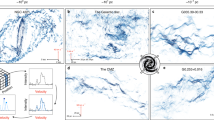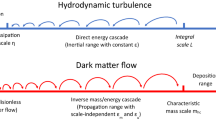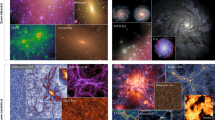Abstract
The local Universe displays a rich hierarchical pattern of galaxy clusters and superclusters1,2. The early Universe, however, was almost smooth, with only slight ‘ripples’, as seen in the cosmic microwave background radiation3. Models of the evolution of cosmic structure link these observations through the effect of gravity, because the small initially overdense fluctuations are predicted to attract additional mass as the Universe expands4. During the early stages of this expansion, the ripples evolve independently, like linear waves on the surface of deep water. As the structures grow in mass, they interact with each other in nonlinear ways, more like waves breaking in shallow water. We have recently shown5 how cosmic structure can be characterized by phase correlations associated with these nonlinear interactions, but it was not clear how to use that information to obtain quantitative insights into the growth of structures. Here we report a method of revealing phase information, and show quantitatively how this relates to the formation of filaments, sheets and clusters of galaxies by nonlinear collapse. We develop a statistical method based on information entropy to separate linear from nonlinear effects, and thereby are able to disentangle those aspects of galaxy clustering that arise from initial conditions (the ripples) from the subsequent dynamical evolution.
This is a preview of subscription content, access via your institution
Access options
Subscribe to this journal
Receive 51 print issues and online access
$199.00 per year
only $3.90 per issue
Buy this article
- Purchase on Springer Link
- Instant access to full article PDF
Prices may be subject to local taxes which are calculated during checkout



Similar content being viewed by others
References
Saunders, W. et al. The density field of the local Universe. Nature 349, 32–38 ( 1991).
Shectman, S. et al. The Las Campanas redshift survey. Astrophys. J. 470, 172–188 ( 1996).
Smoot, G. F. et al. Structure in the COBE differential microwave radiometer first-year maps. Astrophys. J. 396, L1– L4 (1992).
Peebles, P. J. E. The Large-scale Structure of the Universe (Princeton Univ. Press, Princeton, 1980).
Chiang, L.-Y. & Coles, P. Phase information and the evolution of cosmological density perturbations. Mon. Not R. Astron. Soc. 311, 809–824 ( 2000).
Guth, A. H. & Pi, S.-Y. Fluctuations in the new inflationary universe. Phys. Rev. Lett. 49, 1110– 1113 (1982).
Bardeen, J. M., Bond, J. R., Kaiser, N. & Szalay, A. S. The statistics of peaks of Gaussian random fields. Astrophys. J. 304 , 15–61 (1986).
Oppenheim, A. V. & Lim, J. S. The importance of phase in signals. Proc. IEEE 69, 529– 541 (1981).
Ryden, B. S. & Gramann, M. Phase shifts in gravitationally evolving density fields. Astrophys. J. 383, L33–L36 (1991).
Scherrer, R. J., Melott, A. L. & Shandarin, S. F. A quantitative measure of phase correlations in density fields. Astrophys. J. 377, 29– 35 (1991).
Soda, J. & Suto, Y. Nonlinear gravitational evolution of phases and amplitudes in one-dimensional cosmological density fields. Astrophys. J. 396, 379–394 (1992).
Jain, B. & Bertschinger, E. Self-similar evolution of gravitational clustering: is n = 1 special? Astrophys. J. 456, 43–54 (1996).
Jain, B. & Bertschinger, E. Self-similar evolution of gravitational clustering: N-body simulations of the n = -2 spectrum. Astrophys. J. 509, 517–530 (1998).
Thornton, A. L. Colour Object Recognition Using a Complex Colour Representation and the Frequency Domain. Thesis, Univ. Reading (1998).
Shandarin, S. F. & Zel'dovich, Ya. B. The large-scale structure: turbulence, intermittency, structures in a self-gravitating medium. Rev. Mod. Phys. 61, 185– 220 (1989).
Polygiannikis, J. M. & Moussas, X. Detection of nonlinear dynamics in solar wind and a comet using phase-correlation measures. Sol. Phys. 158, 159–172 (1995).
Ferreira, P. G., Magueijo, J. & Górski, K. M. Evidence for non-Gaussianity in the COBE DMR 4-year sky maps. Astrophys. J. 503, L1– L4 (1998).
Pando, J., Valls-Gabaud, D. & Fang, L. Evidence for scale-scale correlations in the cosmic microwave background radiation. Phys. Rev. Lett. 81 , 4568–4571 (1998).
Bromley, B. C. & Tegmark, M. Is the cosmic microwave background really non-gaussian? Astrophys. J. 524, L79–L82 (1999).
Matarrese, S., Verde, L. & Heavens, A. F. Large-scale bias in the universe: bispectrum method. Mon. Not. R. Astron. Soc. 290, 651– 662 (1997).
Scoccimarro, R., Couchman, H. M. P. & Frieman, J. A. The bispectrum as a signature of gravitational instability in redshift space. Astrophys. J. 517, 531 –540 (1999).
Verde, L., Wang, L., Heavens, A. F. & Kamionkowski, M. Large-scale structure, the cosmic microwave background, and primordial non-Gaussianity. Mon. Not. R. Astron. Soc. 313, 141– 147 (2000).
Stirling, A. J. & Peacock, J. A. Power correlations in cosmology: Limits on primordial non-Gaussian density fields. Mon. Not. R. Astron. Soc. 283, L99– L104 (1996).
Foley, J. D. & Van Dam, A. Fundamentals of Interactive Computer Graphics (Addison-Wesley, Reading, Massachusetts, 1982 ).
Melott, A. L. & Shandarin, S. F. Generation of large-scale cosmological structures by gravitational clustering. Nature 346, 633–635 (1990).
Beacom, J. F., Dominik, K. G., Melott, A. L., Perkins, S. P. & Shandarin, S. F. Gravitational clustering in the expanding Universe—controlled high resolution studies in two dimensions. Astrophys. J. 372, 351– 363 (1991).
Author information
Authors and Affiliations
Corresponding author
Rights and permissions
About this article
Cite this article
Coles, P., Chiang, LY. Characterizing the nonlinear growth of large-scale structure in the Universe . Nature 406, 376–378 (2000). https://doi.org/10.1038/35019009
Received:
Accepted:
Issue Date:
DOI: https://doi.org/10.1038/35019009
This article is cited by
-
Cosmological N-body simulations: a challenge for scalable generative models
Computational Astrophysics and Cosmology (2019)
-
Fast cosmic web simulations with generative adversarial networks
Computational Astrophysics and Cosmology (2018)
Comments
By submitting a comment you agree to abide by our Terms and Community Guidelines. If you find something abusive or that does not comply with our terms or guidelines please flag it as inappropriate.



